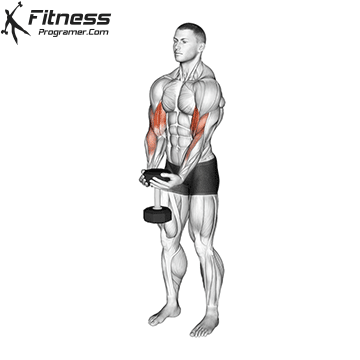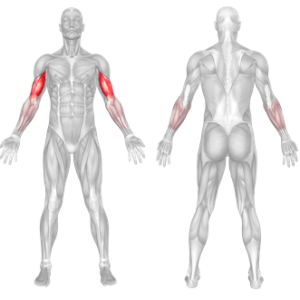Overview
The Waiter Curl is an isolation exercise that targets the biceps brachii, brachialis, and forearms. It’s named for the way the dumbbell is held—similar to carrying a tray—allowing for a neutral wrist position that reduces forearm strain and keeps tension focused on the biceps throughout the lift.
This variation is effective for improving biceps peak, forearm stability, and grip strength, making it a great accessory exercise for arm training.
How to Perform the Waiter Curl

Starting Position: Stand tall with your feet shoulder-width apart, holding a dumbbell vertically in front of you with both hands cupping the top plate.
Grip Setup: Keep your elbows close to your torso and your palms facing upward, supporting the dumbbell from underneath.
Curl the Dumbbell: Bend your elbows to lift the dumbbell toward your chest while keeping your wrists stable.
Squeeze at the Top: Pause for 1–2 seconds, contracting the biceps fully.
Lower Under Control: Slowly return the dumbbell to the starting position without letting it drop.
Repeat: Perform the desired number of repetitions while maintaining strict form.
Tips for Proper Form
Keep elbows tucked to prevent shoulder involvement.
Maintain upright posture—avoid leaning back.
Grip the dumbbell securely to avoid shifting or wobbling.
Move slowly to increase muscle activation and time under tension.
Avoid wrist flexion—keep wrists neutral for safety.
Common Mistakes
Using too much weight, leading to swinging or poor control.
Letting elbows flare out, reducing biceps isolation.
Rushing reps instead of controlling the movement.
Overextending at the bottom, placing stress on the elbow joint.
Tilting the dumbbell, which shifts load unevenly.
Benefits of the Waiter Curl
Isolates the biceps: Reduces assistance from shoulders and forearms.
Enhances peak contraction: Vertical dumbbell position increases constant tension.
Improves forearm stability: Static grip builds grip endurance and control.
Wrist-friendly: Neutral position reduces strain compared to traditional curls.
Simple setup: Requires only one dumbbell and minimal space.
How to Incorporate Into Your Routine
For Hypertrophy: 3–4 sets of 10–12 reps with controlled tempo.
For Strength: 4–5 sets of 6–8 reps with heavier weight and strict form.
For Endurance: 2–3 sets of 15–20 reps with lighter weight.
As a Finisher: Use lighter weights with slow negatives for a final biceps pump.
Waiter Curl Muscles Worked

Frequently Asked Questions
Can beginners do the Waiter Curl?
Yes, start with a light dumbbell to learn the grip and control before increasing weight.
Should I use this instead of regular curls?
It’s best used as an accessory exercise to complement standard curls.
Why do my forearms burn during this exercise?
The static grip heavily engages forearm stabilizers, leading to a strong pump.
Can I use a plate instead of a dumbbell?
Yes, a weight plate can also be used for a similar effect.
How often should I perform this exercise?
1–2 times per week is enough when included in a well-rounded arm routine.
